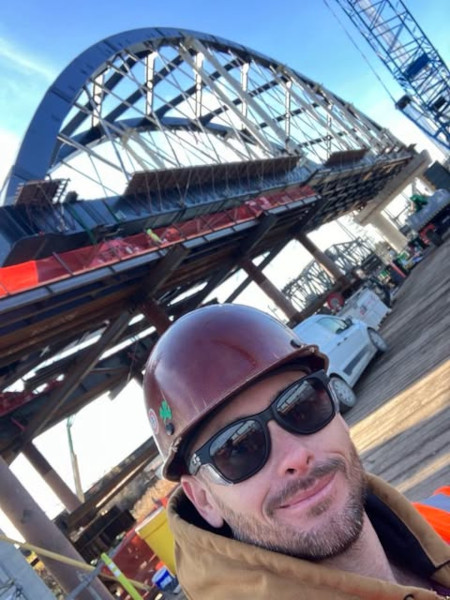Mammoet Raises Massive Arches for US$1.6B Rail Upgrade in New Jersey
_1.jpg)
By Malcolm Ramsay
Mammoet takes you behind the scenes to reveal the equipment and techniques it deployed to lift several vast structures during the replacement of a century-old New Jersey bridge.
From Issue 4, 2025 of Breakbulk Magazine
(4-minute read)
Contracted to execute the heavy lifting scope for the replacement of the century-old Portal Bridge over the Hackensack River in New Jersey, Mammoet has played a critical role in a US$1.6 billion effort to modernize one of the busiest rail routes in the U.S.
Working alongside construction joint venture partners Skanska-Traylor and Carver Marine, Mammoet supported the installation of a new two-track, elevated fixed-span structure – known as the Portal North Bridge – to replace the outdated swing bridge.
The crossing handles up to 450 trains and 200,000 passengers each day, making it one of the most active sections of rail in the country and a longstanding bottleneck on the Northeast Corridor between Newark and New York Penn Station.
“Communication and coordination were a strong focus on this project,” Sidney King, project manager for Mammoet, told Breakbulk. “Mammoet worked in close collaboration with Skanska-Traylor Joint Venture, Carver Marine, and other project stakeholders throughout all phases of the operation. This proactive, transparent approach helped the project team stay aligned and adapt quickly to changing conditions.”
Running roughly parallel to the Hudson River, the Hackensack River is a vital commercial channel for the New Jersey–New York region. The Portal Bridge has long served as a critical rail crossing, but its advanced age and outdated swing mechanism have caused persistent delays for both Amtrak and NJ Transit services.
The bridge upgrade forms part of the Gateway Program, a long-term infrastructure initiative led by Amtrak and New Jersey Transit to expand and improve the reliability of the entire Northeast Corridor between Newark Penn Station and New York Penn Station.
“The new Portal North Bridge is a key component of the signature US$16.1 billion Gateway Program,” said a spokesperson for infrastructure consulting firm AECOM, which provided construction management services for the project as part of a JV with consulting group STV.
High-Tech Modeling
To model the complex bridge replacement, Skanska-Traylor relied on an array of advanced technology, utilizing 3D Building Information Modeling (BIM) alongside EarthCam setups and real-time monitoring systems. This allowed the team to verify performance and maintain phasing discipline, especially important given the site was surrounded by water, rail lines, areas of contaminated soil, and dense urban buildings.
Tasked with making the build as cost efficient and speedy as possible, Skanska-Traylor calculated that assembling the three new arches on land instead of over water would save over US$10 million on temporary foundations and falsework, as well as saving around 33% on labor. This approach also solved many safety issues as crew could assemble the components in a more controlled environment on land.
The downside of this approach, however, was that the massive units would need to be floated to the site and then lifted into position, sometimes with less than an inch of tolerance either way.
“Precision was critical throughout,” said Larry Guli, director of survey at Skanska USA Civil, noting that the survey team helped coordinate across all activities and that “we were within a 16th of an inch in the worst cases.”
The technical challenges in achieving this monumental infrastructure project were immense and involved several major project cargo moves, not least the installation of three giant arches, weighing over 2,200 tonnes each.
“It is a focal point for us, and New York looks at it that way too,” said Dan Payea, senior vice president of operations for Skanska USA Civil. “You cannot close waterways in the U.S., which makes going over an active waterway particularly challenging. It was much more economical to build three separate bridges elsewhere, and we installed them on big jacks before lifting them into the final position.”
Leveraging their extensive experience in bridge installations, Mammoet began the project by developing a detailed plan to plot the delivery of each section. Given the dense urban development that surrounds the bridge, the logistics of transporting the massive bridge sections to the site was not straightforward and the route had to be chosen to minimize disruptions and ensure efficient installation.
For this reason, the bridge sections were assembled at the Port of Coeymans, near Albany, some 130 miles north in upstate New York. The location was strategically chosen for its access to the Hackensack River and its ability to accommodate the large-scale assembly of the bridge sections. However, the distance from the site meant that the components would make a 30-hour journey downstream, and had to be carefully maneuvered past 19 bridges along the river.
River Transfer
 To achieve this, the bridge sections were loaded onto barges at the Port of Coeymans for transit down the Hudson River to a temporary mid-river staging area called the transfer bent.
To achieve this, the bridge sections were loaded onto barges at the Port of Coeymans for transit down the Hudson River to a temporary mid-river staging area called the transfer bent.
“One of the key contingencies we had to plan for was tide,” King explains. “Tidal variations impacted nearly every phase of the project – from roll-on at the Port of Coeymans, to temporary staging on the mid-river transfer bent, to final installation of the bridge sections.
“To mitigate this risk, the client performed daily tidal measurements well in advance of the operations. Roughly one week prior to each major move, Mammoet and the project team would analyze this data to make educated assumptions about the target windows for safe operations.”
Made of structural steel, the huge arches were painstakingly constructed at a yard in Coeymans, with teams from AECOM, STV, and Traylor Bros helping to oversee the project management.
Based on a tied arch system, the design allows the bridge to rise 50 feet over the river, providing sufficient clearance for maritime traffic without the need for a movable span. For transport from the yard, Mammoet utilized Self-Propelled Modular Transporters configured in a four-train setup, using a total of 112 axle lines with eight tires per axle line.
“Each axle line had a capacity of 40 tonnes, providing the mobility and load capacity needed to safely transport bridge sections – each over 120 meters (~400 ft) in length – from the assembly site at the Port of Coeymans to the roll-on location,” King notes. “All the equipment choices were driven by the need for high-capacity handling, adaptability to tidal variations, and strict accuracy requirements.”
Precise Control
Having arrived by barge at the temporary transfer bent, the next phase for delivery of each arch was to move it onto a secondary barge equipped with Mammoet’s Mega Jack system. The heavy-lift solution is designed to manage massive loads with unparalleled precision and is composed of multiple jacking towers which can be strategically configured to lift and position large structures.
For this project, its position on the back of the barge meant that the arches could be floated into position then jacked up in place.
“Mammoet selected the Mega Jack as it provided a superior degree of stability, speed, and safety compared to traditional climbing jack systems. The Mega Jack allowed us to jack the bridge sections 14–16 cassettes high, giving the project team precise control over final positioning,” King explains.
“Additionally, the Mega Jack was configured with contingency cassettes that allowed us to adjust for changing water levels. The fast operation of the Mega Jack was crucial for managing short tidal windows and ensuring precise, stable placement of the bridge sections.”
Alongside the calculable changes due to tides, Mammoet also had to contend with plummeting winter temperatures, bringing freezing wind and ice.
“Weather was a significant challenge, especially during the winter phases of the project,” King recalls. “High winds and extremely cold temperatures required additional precautions to maintain safety and equipment reliability. During these periods, snow was cleared from the barges prior to operations and heaters were used on critical equipment to ensure proper functioning.”
Lateral Positioning
To further mitigate risk for the move, it was necessary to schedule adjustments to take advantage of more favorable weather windows, as well as planning for shipment at night when the waterway was quieter. Through a collaborative approach with other stakeholders, this allowed the project to maintain momentum and deliver safe, effective results, despite the environmental challenges.
“Prior to each major operation, Mammoet participated in daily planning meetings with the client to review updated weather and tidal forecasts and to jointly determine go / no-go thresholds – particularly for wind and tide conditions,” King notes, adding that Mammoet was “also actively involved in developing and refining the project schedule, providing recommendations to enhance operational efficiency.”
A further element in the project plan that eased delivery was the addition of Mammoet’s slide track system for installation of the East and West bridge sections. This enabled fine lateral positioning of the spans onto their permanent columns.
New Jersey Governor Phil Murphy welcomed the milestone, saying: “Together, we are transforming the Portal North Bridge into an access point that will provide our rail passengers with a more reliable commute, and our entire region with economic opportunity.”
With the third and final network tied arch successfully installed, the outline of the new bridge structure is now clear, and this has allowed construction to progress to “the installation of catenary poles, ballast, tracks, and power wires” a spokesperson for NJ Transit said.
The Portal North Bridge replacement project is expected to be completed in late 2027.
Mammoet will be exhibiting at Breakbulk Americas 2025.
Photo credit: Mammoet
